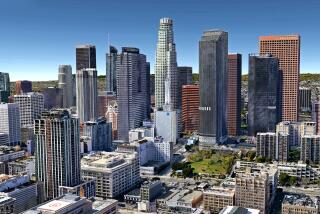Architects Find Old Car Dealership Is Their Style
One of Los Angeles’ earliest auto dealerships, a fixture in what was once the city’s Little Italy district, will live on as the new headquarters of a prominent architectural firm.
Johnson Fain, the Los Angeles firm that designed such landmarks as Fox Plaza and the new MGM Tower in Century City, bought the former Basso Chrysler/Jeep dealership building just north of Chinatown on North Broadway and is converting the old showrooms and service garage into offices and design studios for about 100 employees.
Part of the appeal for the firm is the utilitarian architecture from an earlier era. Behind a small showroom where new automobiles were once displayed to passersby are two larger brick warehouse-sized spaces with vaulted bow-truss ceilings and skylights. One was used as a showroom; the other, a service garage.
“It’s really quite terrific inside,” said architect Scott Johnson, the firm’s design partner, who is overseeing the $1.5-million makeover. The long-sealed clerestory skylights and windows will be reopened to illuminate the workspace of architects, model makers and digital animators.
Johnson Fain, whose managing partner is William H. Fain Jr., paid $2 million for the Basso site. The firm is moving from a 14,000-square-foot space in the downtown financial district.
The new 26,000-square-foot headquarters overlooks an abandoned 32-acre rail yard -- called the Cornfield -- that is expected to become a state park. The property is near the original Casper de Portola encampment of 1781, which marked the city’s beginning as a pueblo at a bend in the Los Angeles River.
The area later became home to Italian immigrants who at one point converted the Avila Adobe, the city’s oldest building, into an Italian restaurant. In 1923, immigrant Domenich Basso built an auto dealership at 1201 N. Broadway. It remained in business until last year.
Basso sought a more sedate living after an automobile racing career that started in 1908, when competing cars carried a driver and a mechanic. Basso rode beside “Terrible” Teddy Tetzlaff as a mechanic when he set a speed record of 142.85 mph on a Utah salt flat in 1914. He also rode with race car driver Eddie Rickenbacker, who went on to become the top U.S. pilot in World War I.
Basso gave up professional racing in 1916 after a long stay in a Kalamazoo, Mich., hospital. He wound up there after the racing car he was riding in blew two tires on a turn, jumped a fence “and wound up in a sensational triple summersault,” according to The Times.
In the 1930s, Los Angeles officials moved residents of Chinatown into much of what had been Little Italy to make way for construction of Union Station on Alameda Street. Basso’s dealership continued to prosper, selling Essex, DeSoto and Plymouth automobiles, among others.
Basso hired his future son-in-law, Joe Boccalero, in 1941. The young man took time out from the business to serve in the Army under Gen. George Patton in World War II. He was captured during the Battle of the Bulge in the winter of 1944 but survived and returned to Los Angeles.
When Basso died in 1963, Boccalero took over the running of the dealership that was left to his wife, Alberta, and sister-in-law, Alma Connolly.
For years, Boccalero displayed in a window facing Broadway an olive drab World War II Jeep that he rescued from a ditch on Santa Catalina Island long after it had been used in the filming of the 1949 World War II movie “Sands of Iwo Jima,” starring John Wayne.
Connolly and the Boccaleros sold their interests in the property to Johnson Fain last year, said real estate broker Dwight Hotchkiss of Cushman & Wakefield, who represented the sellers.
The sale is part of “a huge transformation” of real estate around Chinatown “to higher and better uses,” Hotchkiss said.
More to Read
Inside the business of entertainment
The Wide Shot brings you news, analysis and insights on everything from streaming wars to production — and what it all means for the future.
You may occasionally receive promotional content from the Los Angeles Times.










